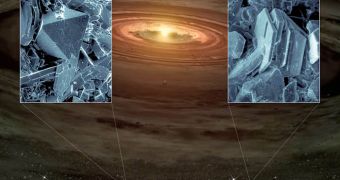The Spitzer Space Telescope has recently made a startling discovery as it was scouring the skies in thorough observation of five young planet-nascent disks approximately 400 light years away from the Earth. While it was largely known that crystallized dust particles constantly lump up into larger versions, ultimately the size of planets, the discovery of silica-based (oxygen and silicon) cristobalite and tridymite crystals in the protoplanetary disks surprised them.
The surprise is generated by the fact that this kind of silica crystals require bursts of heat and rapid cooling for their formation process. Scientists from the University of Rochester, New York, namely William Forrest and graduate student Ben Sargent, who led the research, indicate that the crystals need a temperature of 1,220 Kelvin (about 947 degree Celsius or 1,740 degrees Fahrenheit) for formation purposes, while the accretion disks only provide 100 to 1,000 Kelvin (about -173 to 727 degree Celsius or -280 to 1,340 Fahrenheit).
Therefore, they deduced that the excess temperature must come from shock waves, the only phenomenon that can sport this kind of sporadic heat in the region. These are supersonic pressure waves in the planetary disks which occur upon collision of high-speed, massive gas clouds.
"Spitzer has given us a better idea of how the raw materials of planets are produced very early on," said Forrest, in a Caltech press release. "By studying these other star systems, we can learn about the very beginnings of our own planets 4.6 billion years ago."
Indeed, the discovery concurs with what is known of the beginning of our own solar system, when spheric-shaped grains named chondrules are believed to have undergone a forced crystallization process due to the shock waves occurring within our protoplanetary disk. Also, NASA's Stardust mission discovered tridymite minerals in the composition of the comet Wild 2.

 14 DAY TRIAL //
14 DAY TRIAL //